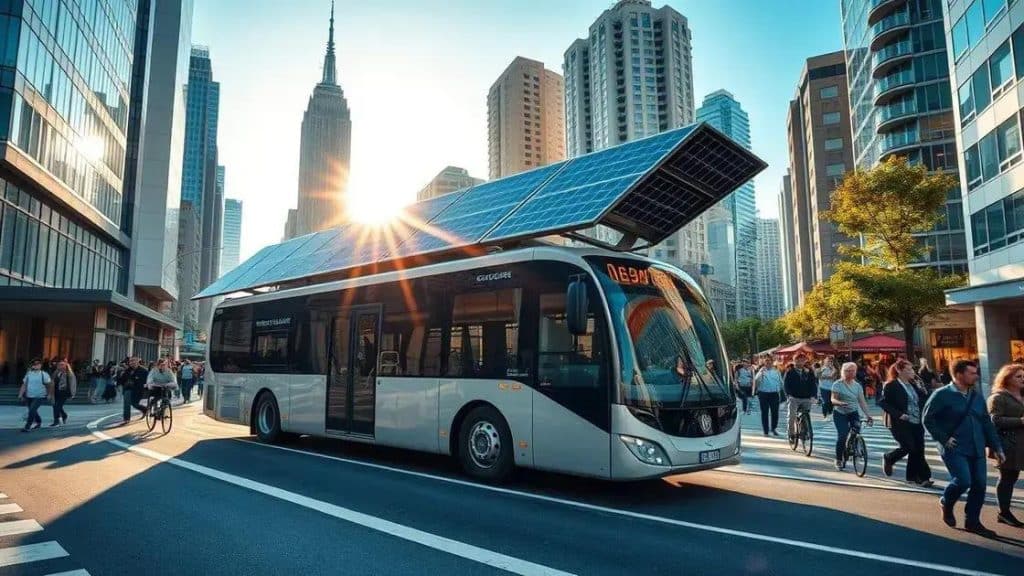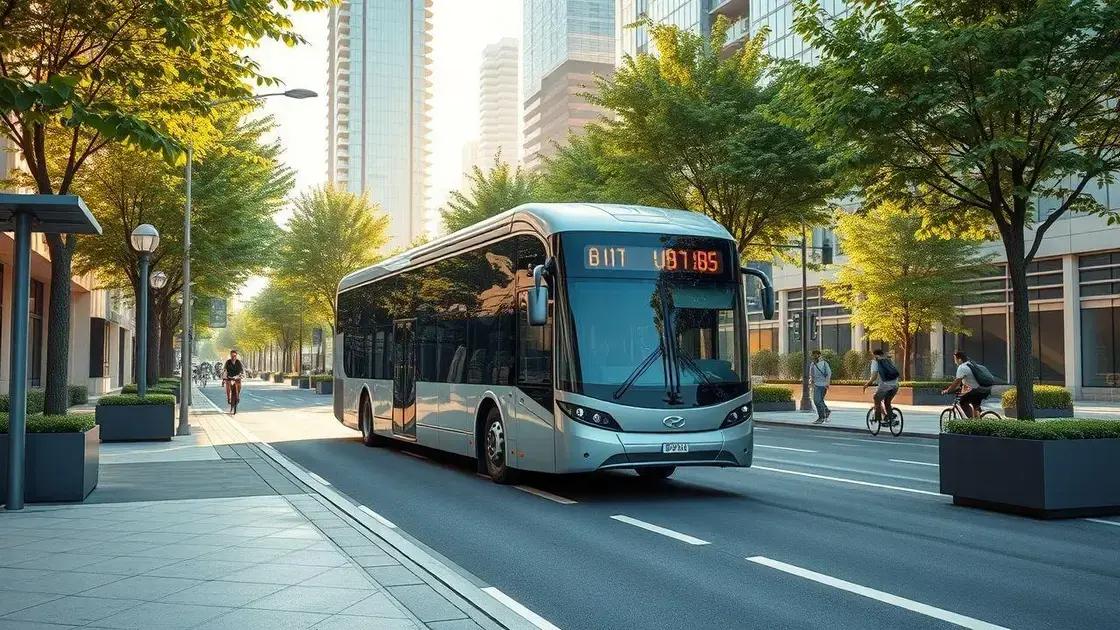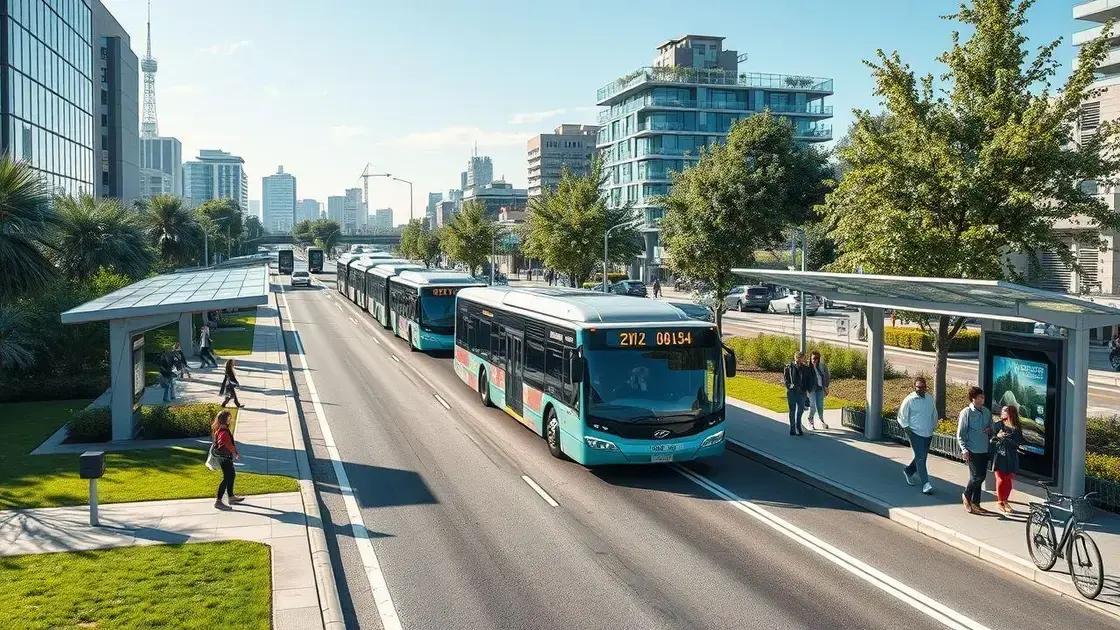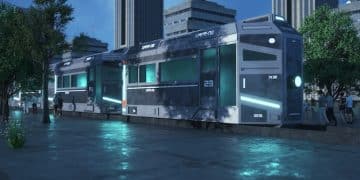Renewable energy integration in public transport: a game changer

Renewable energy integration in public transport enhances sustainability through electric buses, advanced technologies, and community engagement, leading to reduced emissions and improved urban air quality.
Renewable energy integration in public transport is more than just a buzzword; it’s a crucial step toward sustainable urban mobility. Have you ever considered how this shift could reshape your daily commute? Let’s dive into the possibilities.
The role of solar power in public transport
Solar power is playing an essential role in the evolution of public transport. By harnessing the power of the sun, cities are looking for ways to reduce their carbon footprint and enhance sustainability.
Benefits of Using Solar Energy
Switching to solar energy can significantly change the dynamics of public transport systems. Solar panels can be installed on buses, trains, and even stations, which helps to reduce operational costs.
- Cost Savings: Solar energy can lower electricity costs for public transport.
- Reduced Emissions: Shifting to solar power cuts down greenhouse gas emissions.
- Energy Independence: Utilizing solar energy increases energy security for municipalities.
- Enhanced Public Image: Investing in renewable energy improves the image of public transport services.
Furthermore, cities that invest in solar power often experience an increase in ridership as people become more environmentally conscious. The visibility of solar-powered vehicles can encourage more individuals to use public transport.
Implementation Challenges
While the transition to solar power brings many advantages, there are challenges to consider. The initial investment for solar technology can be high, and infrastructure needs significant planning and resources.
Additionally, weather conditions can impact solar energy production. Proper energy storage solutions must be in place to ensure reliability. As more cities explore the integration of renewable energy into their public transit systems, these challenges need strategic solutions.
In conclusion, harnessing solar energy for public transport can lead to a greener future. By providing cost-effective, sustainable power sources, solar energy can revolutionize how we think about public transport. Many cities are already leading the way, showing that a brighter, more sustainable future is possible.
Benefits of electric buses for urban systems

Electric buses are becoming a vital part of urban transport systems. Their benefits extend beyond just being a cleaner alternative; they offer efficiency and cost savings.
Environmental Advantages
The transition to electric buses significantly reduces pollution levels in cities. These buses produce zero tailpipe emissions, leading to improved air quality. A healthier environment can positively impact the well-being of city residents.
- Reduced Greenhouse Gases: Electric buses help lower the carbon footprint.
- Noise Pollution Reduction: They operate more quietly than traditional buses.
- Better Urban Aesthetics: With no exhaust fumes, city spaces feel cleaner.
Additionally, electric buses contribute to a sustainable urban ecosystem. As cities seek to adopt more renewable energy sources, electric buses align perfectly by using energy from wind and solar systems.
Cost-Effective Operations
Operational costs for electric buses are generally lower compared to diesel buses. They require less maintenance, as electric engines have fewer moving parts. This leads to reduced downtime and lower repair costs.
Moreover, with advancements in battery technology, the range of electric buses continues to improve. This allows them to operate effectively throughout the day without frequent charging, making them an ideal choice for busy urban environments.
Integrating electric buses also opens up funding opportunities. Many governments offer incentives for transitioning to electric fleets, benefiting urban transport authorities financially. As cities aim for cleaner transport, electric buses stand out as a practical and impactful solution.
Challenges in implementing renewable energy solutions
Implementing renewable energy solutions in public transport presents several challenges. While the benefits are clear, various obstacles must be overcome to ensure a successful transition.
High Initial Costs
One of the main challenges is the high upfront costs associated with renewable technologies. Solar panels and electric bus infrastructure can require substantial financial investment.
- Funding Limitations: Many transportation agencies operate on tight budgets, making it difficult to allocate funds for new technologies.
- Long-term ROI: Although renewable energy solutions lead to savings in the long term, the initial costs can deter immediate adoption.
- Grants and Incentives: Securing grants for renewable projects can be competitive and time-consuming.
Moreover, the financial burden of upgrading existing systems poses additional hurdles. Many cities have outdated fleets, requiring a comprehensive strategy to replace them while maintaining service levels.
Technical Barriers
The integration of renewable energy also faces technical challenges. For example, electric buses need robust charging infrastructure to function effectively. This infrastructure must be strategically located to support widespread usage.
Furthermore, older transit systems might not be compatible with new technology. This can lead to disruptions in service and added costs during the transition phase.
Additionally, the availability of charging stations can limit the operational range of electric buses. To combat these issues, planners must find ways to enhance infrastructure while keeping costs manageable.
In conclusion, addressing the challenges of implementing renewable energy solutions in public transport requires careful planning and commitment from both authorities and community members. With the right strategies, these obstacles can be systematically tackled, paving the way for a cleaner and more efficient transit future.
Future outlook for public transport sustainability

The future outlook for public transport sustainability is promising as cities around the world are beginning to embrace innovative solutions. Integration of renewable energy and advanced technologies will shape how we view and utilize public transport.
Innovative Technologies
New technologies are paving the way for smarter public transport systems. Electric buses and hybrid vehicles are becoming more common, providing cleaner alternatives for urban travel.
- Smart Grids: These systems can optimize energy use, ensuring that public transport is both efficient and sustainable.
- Real-time Data: Utilizing big data allows cities to improve scheduling, reducing wait times and energy consumption.
- Autonomous Vehicles: As self-driving technology matures, it promises to enhance safety and efficiency in public transport.
Furthermore, advanced battery technologies are increasing the range and reliability of electric buses. This means they can operate throughout the day without frequent charging, which is crucial for busy urban environments.
Focus on Community Engagement
Community involvement will also play a significant role in shaping the future of sustainable public transport. As citizens demand greener options, local governments are listening.
Public consultations and surveys can help identify the needs of the community. Engaging with residents allows for tailored solutions that reflect local circumstances.
Moreover, educational campaigns can raise awareness about the benefits of using public transport. Highlighting the impacts on air quality and traffic congestion can motivate more people to choose public transport as their primary mode of travel.
The vision for sustainable public transport systems includes not only cleaner vehicles but also efficient networks designed around user needs. A focus on accessibility ensures that public transport serves everyone, contributing to a more equitable society.
FAQ – Frequently Asked Questions about Renewable Energy in Public Transport
What are the main benefits of using electric buses in urban transport?
Electric buses reduce greenhouse gas emissions, lower operational costs, and improve air quality in cities.
How can communities be involved in the transition to sustainable public transport?
Communities can participate through public consultations, offering feedback on transport needs and preferences essential for planning.
What are the challenges of implementing renewable energy solutions in public transport?
Challenges include high initial costs, the need for infrastructure upgrades, and ensuring compatibility with existing systems.
What technologies are shaping the future of public transport sustainability?
Innovative technologies include smart grids, real-time data analytics, and electric and autonomous vehicles, all contributing to sustainability efforts.





